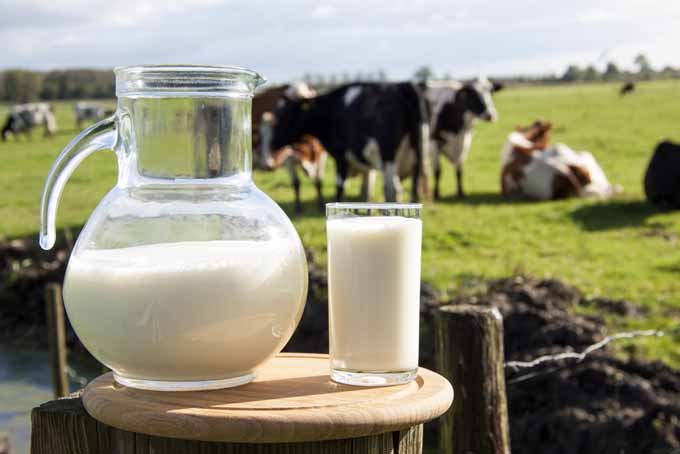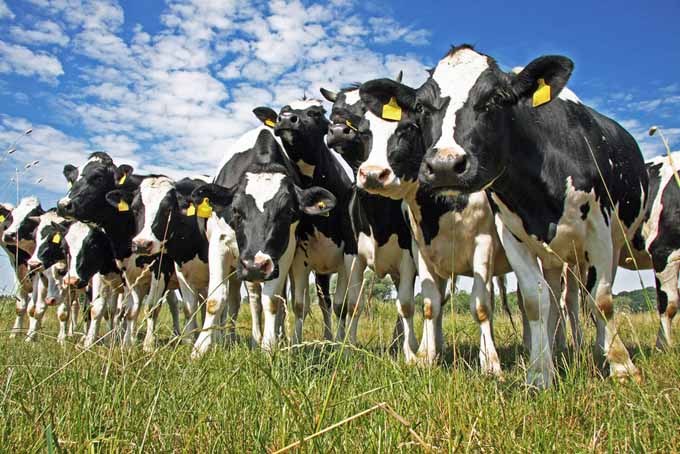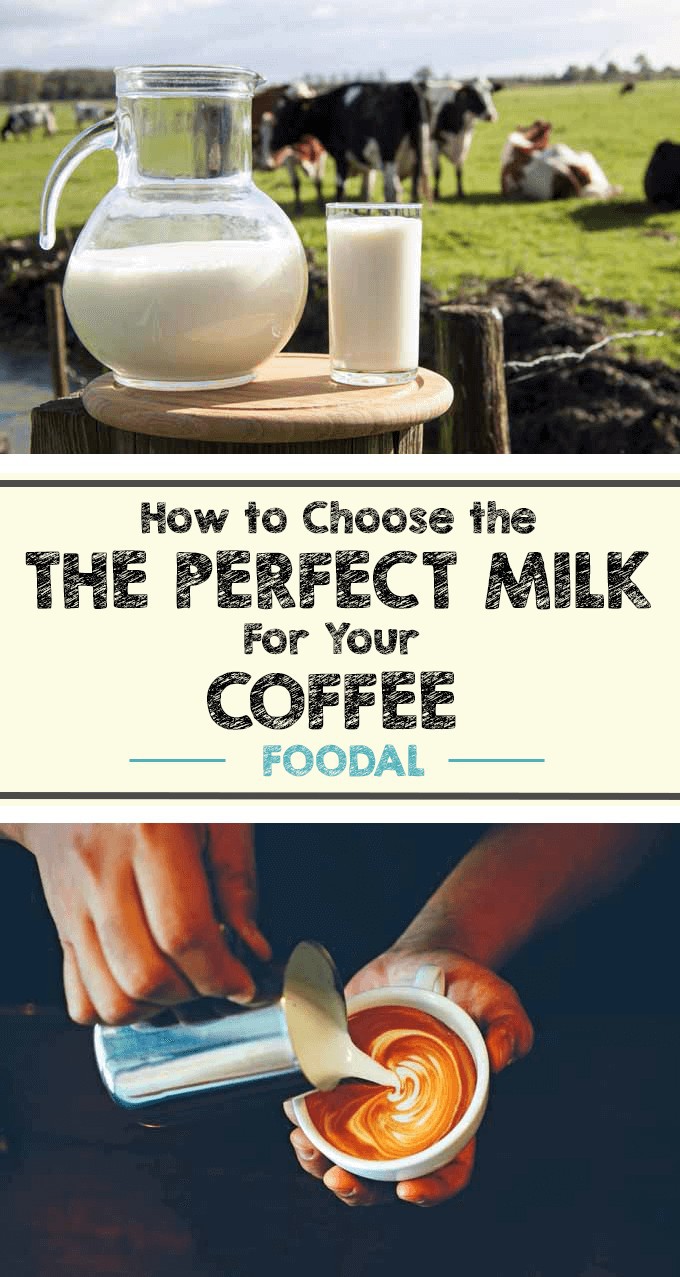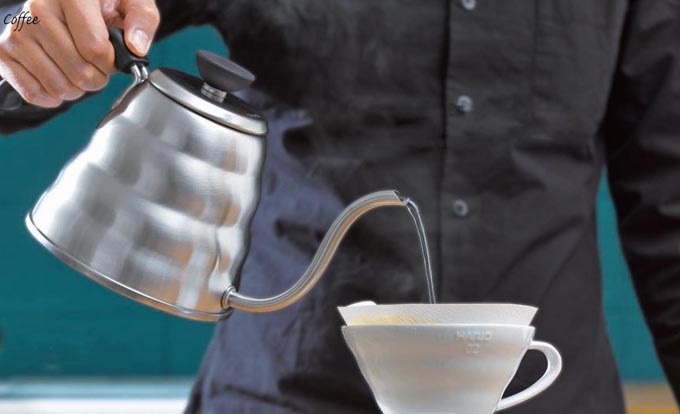So much time and attention is put into the choice of coffee beans, the roasting process, the grinding, and the brewing.

If we are looking for the perfect latte or cappuccino drink or even seeking to make that perfect cup of regular drip, shouldn’t we also be putting more time and attention into using the best milk products in our coffee drinks?
Why Milk?
Although some coffee purists may believe that adding dairy products to coffee ranks in the same category as the Seven Deadly Sins, others enjoy a little cream in their coffee and use it for a variety of reasons.
We add dairy to our coffee to provide nutritive value, including calcium and vitamin D.
Also, whereas coffee can sometimes be acidic and potentially cause stomach problems, putting some form of dairy in the coffee has a kind of “coating” effect, which tempers the potential for adverse reactions.
Which Milk?
With so many options on the market today, it may seem overwhelming to decide which one is preferable.
But just taking a few minutes to educate ourselves on what is available will go far in improving the quality of our coffee beverages.
Here are some factors to consider when choosing the perfect dairy products in your local area:
Origin
Cow’s milk is the most basic and easiest to come by, although some people enjoy experimenting with varieties from other animals such as goats.

In addition to knowing what animal the dairy product comes from, it can be beneficial to know where it comes from geographically. Buying food that is produced locally helps the environment and the local economy.
Also, buying locally produced dairy products can be particularly helpful in knowing that the product is fresh.
Dairy Fat
The amount of fat can be a controversial issue when it comes to coffee (or any food or beverage product). Although consuming lower fat products may be better for our health, they are also likely to provide a lower-quality, “thinner” tasting coffee beverage.

Because the fat is what makes dairy products thick and creamy, non-fat milk almost has the effect of watering down the coffee beverage instead of adding to its flavor and structure.
Types of Dairy
Half-and-Half
Half-and-Half, which is often poured simply into a cup of brewed coffee, is a blend of milk and cream. With 12% fat, it comes in with a much more dense and creamy consistency than plain milk.
This usually means that less is needed in a cup of black coffee than would be used in, say, a latte or cappuccino. This is exceptional when frothed in an espresso machine or with a dedicated frother.
In comparison, light cream and heavy cream are between 20% and 40% fat, and are really only useful for baking and cooking rather than adding to coffee.
The only exception might be that heavy cream is often used for whipping, which means that sugar and air are mixed in to provide a lovely garnish for some fancier coffee beverages.
Whole
Whole Milk is the barista’s best friend.
With around 4% fat, this form of dairy may be considered less “healthy” for those on a lower fat diet, but also brings with it a richness of texture on the palette that many people enjoy.
This one is a great pick for those who don’t have a frothing system at home but want something that is rich.
Reduced Fat
Reduced Fat Milk usually comes in at 1% or 2% fat and is a good compromise for a person who is adding a milk product to their coffee every day.
There is some loss of flavor and texture, but the balance comes in with the benefits of not overdoing it on the fat.
Skim
Skim or Fat-Free Milk, contains no fat at all. Because it is the fat that makes the liquid taste creamier, there is some loss of flavor when using a skim product.
It does, however, create foam that is less “fluffy,” which some people prefer. And, it may bring with it a slight bit of sweetness that is not found in whole or other reduced fat varieties.
About Organic
There is some controversy in the dairy world about organic versus milk that comes from conventional farms. Truly, the difference is often related to the size of the farm.
Local, organic co-ops are typically a little better at making sure their cows are treated to pasture feeding, as they are more able to “micromanage” their herds (and more importantly their grass) a little more closely than larger operations.

It should be noted that ALL dairy (and beef) cows are fed mostly from grass, however, grain products are given to dairy cows to boost their rate of production and as a lure to get them to return to the milking barns.
Often times, the taste of purely pasture-fed milk speaks for itself and is worth a taste test.
As we brew exquisite coffee drinks at home, we want to make sure that the coffee is paired with better dairy products to bring out the finest flavor.
Putting thought into the selection of our milk products, including consideration of the type, origin, fat content, and flavor, is an excellent step toward experiencing the perfect cup of coffee.
Want to be more hip to java? Make sure to check out our glossary of coffee terms you absolutely should know the deeper you get into the world of coffee!
About Julie Workman
As a freelance writer for over 15 years, Julie Workman has been published in various magazines, books, and online media. She holds a college degree in Home Economics which she uses every day in overseeing her household and making her home a happy place for her family.






This was very educational. I would have never though about how different types of creme or milk added to my coffee could alter its taste. I also didn’t know that coffee could be acidic – thanks – I’ll have to stop drinking plain black from now on and make sure to add some creme to it.
I liked this informative post. I sometimes have problems with dairy and coffee combined together. Though we usually buy non dairy creamer so I don’t experience any cramps. I don’t think I’m lactose intolerant completely. I just might have a limit as to how much I can take daily. The worst part is that I often times get acne from taking in milk in any form.
Reduced fat (or what we call “semi-skimmed” here in the UK) every time for me. whether I’m having a latte or simply adding a splash of milk to an instant coffee. Skimmed is far too watery for my liking and whole milk seems too heavy and fatty. Semi-skimmed is an excellent compromise.
I love to make my own creamer with 2 parts heavy cream and one part milk and some vanilla extract. I combine them together and shake them up in a bottle. At this point, I know exactly what is in it and it taste pretty good. Plus, this means less sugar!
This is an excellent idea. And so much better than the flavored versions in the stores that are packed full of chemicals. Thanks for sharing.
Half and Half is in my opinion the best tasting! No matter what brand you buy in the store the coffee always becomes so smooth! I would stay away from “semi”skimmed” milk though. I prefer a more natural choice. Full fat all the way! 🙂
Considering that my grandfather is lactose intolerant and my mother is intolerant of half and half, it’s interesting to see the variety of different milk products that we have in our refrigerator at a given time. This was an interesting read overall, and I’d like to use it to cut down on the number of different types of milk that my family has to buy on the weekly run to the grocery store. I’ll keep these options in mind the next time I go. Thank you for the educational article!
All ignorance in regard to what type of milk, for me, has been banished, when it comes to coffee or tea, any type of milk is milk, but to go through this article and find out that there is a variety, well, I must say knowledge is important/power, next time am brewing a cup of coffee, I’ll keep this in mind. 😉
Funny how I stumbled upon this informative piece right after finishing up my own cup of coffee with powdered milk. I never knew there were so many types of dairy to choose from; might try a few of your examples to see which one hits the spot for a sweet-tooth like me. It’s about time I actually tried the natural, non-processed ones anyway.
In my own opinion, the consistency of whole milk is the perfect duality between creamy and thin. Whenever I look for a good creamer for my coffee, I always taste test it before I add it to the drink. The taste test allows me to measure the texture of the liquid to maximize the feel of the coffee. To me, whole milk, also being a healthy drink on its own, is a perfect addition to coffee. I use organic from my local farmer’s market because it’s a more natural coffee combination. With that said, I also use regular creamer on occasions where I cannot use whole fat.
Thank you for the informative article! I used to use milk and sugar in my coffee, but found it took a lot of the taste out of the experience. In my house I’m the only one who likes whole milk, so I had to make do with 2% or low-fat, and it made my coffee taste gross. So I’ve had to adapt and drink it black.
I may have to get a 1/2 gallon of whole and reacquaint myself with cream in my coffee again. This has me craving a nice hot cup of joe right now…
Great article. I’m wondering if you have any suggestions when it comes to non-dairy milk. I’m lactose-intolerant, so I can’t digest cow’s milk, unfortunately. But I still crave that creamy flavour when it comes to coffee and tea. I enjoy almost all non-dairy milks, but would love advice on how to choose the right one, especially with nut milks.
Interesting take on things. Coffee may very well taste better with an appropriate dairy selection, but I avoid it anyway. I do what I can to avoid adding any extra carbs or sugars to my beverages.
Great point about the extra carbs. I enter my food on MyFitnessPal and it wasn’t until just last week that I realized that even coffee has carbs!
I’ve tried them all. Seriously! In my quest to find what taste good to me, but is low in calories, I’ve truly tried them all. I’ve decided to take taste over losing weight. haha! I’m using organic half & half right now and see no reason to go back to other types of flavoring or choices that I’ve used in the past.
I also can’t imagine drinking milk that is not organic after all the research and data that has come out about hormones and such in milk and other foods. I love coffee and found this article making me want some now. Time for a fresh pot.
I love using whole milk to make lattes. My housemates love me because I whisk until it’s frothy. It makes the lattes incredibly light!
Very informative article! I frequent Starbucks at least once or twice per week, and always get my drinks with whole milk or breve (cream). The taste is so much better than if I had ordered it with skim. I love the creamy texture of half and half or whole milk in my coffee. Soy milk is also very good for people who might have dairy allergies. On that note, I am now in the mood for an iced latte 😉
Wow! I have never thought of deciding what milk I would but in my coffee! I don’t drink coffee without milk, it’s too strong for me and I don’t like the taste. But I always take the milk we have at home, not thinking there are more options! Thank you for this article, I will definitely try different types of milk to add to my coffee!
Great post…and I must say as a coffee enthusiast I would definitely agree I love cream in my coffee. I can use the dairy creamers (flavored) just fine and it really enhances the taste of my coffee and makes it somewhat rich and creamy if you will. Actually my addition of choice is almond milk, and I love this stuff. I am a big fan and thank you for the information about the coating effect, very interesting.
I used to work in a coffee shop and the milk is so important! Not just for flavour but for texture too, each type of – latte, cappucino, flat white etc has a different method for texturising the milk, cappucino has very frothy milk for example and to achieve the right texture it’s best to use full fat milk, it’s tastes the best too!
One must try the south east Asia Chinese style: add evaporated milk to very strong coffee. It’s really good.
For me, milk makes the coffee…. If you don’t use the correct milk the coffee taste will just not be what it is suppose to be. The milk enhances the taste and enjoyment. I love full cream milk, it’s the most natural and satisfying. Thanks for the article it is really well written and full of useful information
I’m a person that can’t drink coffee without milk, it tastes too weird. That being said, because I live on the countryside I usually mix coffee with organic milk and it’s delicious, haven’t tried other types yet.
I have been using 1% milk and I have to add a lot of milk just to make the coffee taste creamy. When I used a half and half or even whole milk the difference in taste is noticeable compared to skim or 1% milk. So much richer! The Land o’ Lakes light half and half cream is a good compromise if you don’t want your milk to be fatty.
For me, milk makes the coffee. I love using whole milk to make lattes.
you share each step very clearly thnx for best article